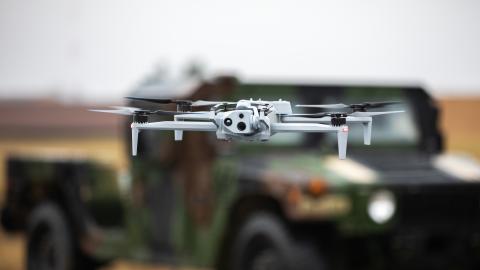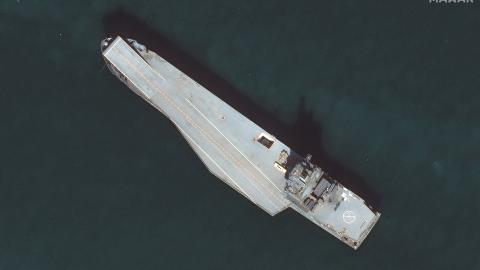Iran’s Drone Carrier Program: An Overview
To help address its conventional military industrial disadvantages, the Islamic Republic of Iran has been converting commercial vessels into drone carriers and naval missile launch platforms. Tehran has outfitted basic commercial ships with carrier decks and asymmetric offensive weapons such as combat drones, bomb-laden unmanned boats, and anti-ship ballistic missiles. These new platforms appear capable of wreaking havoc in the region.
Since Tehran modifies these vessels with predominantly commercial components, traditional arms control measures are ineffective at restricting their construction. While Tehran cannot match its adversaries’ technologically superior aircraft carriers and helicopter landing docks, these makeshift vessels allow Iran to imperil regional maritime shipping and threaten the United States’ naval presence in the Middle East.
Iran Commissions Its First Drone Carrier
In early February 2025, Iran’s first drone carrier, the IRIS Shahid Bagheri, officially joined the Islamic Revolutionary Guard Corps (IRGC) Navy. The inauguration ceremony was held in the city of Bandar Abbas, strategically positioned on the Strait of Hormuz.
Iran’s new naval platform might look technologically and structurally inferior to modern aircraft carriers and amphibious assault vessels. But a careful assessment of the vessel’s design philosophy reveals that Iran has taken the lessons from the success of its Yemen-based Houthi proxy and implemented them at a larger scale. Like the Houthi arsenal, these makeshift drone carriers are designed to create tactical advantages and strategic leverage.
The Shahid Bagheri was formerly a container ship, the Perarin. With a length of 787 feet and a takeoff runway of approximately 570 feet, the Shahid Bagheri is well-equipped to support a variety of Iranian drones, including loitering munitions. Vertical takeoff platforms can launch from and land on the carrier without any special modifications. The vessel also boasts a unique design feature: an angled flight deck, akin to a ski jump, that points toward the vessel’s starboard edge. This design allows the flight deck to extend beyond the Perarin’s chassis, lengthening the runway and allowing larger drones to launch from the carrier.
Nonetheless, satellite imagery shows that the design of the carrier’s flight deck leaves little room for heavy aircraft recovery operations, since any landing errors could damage the vessel. It is unknown whether the craft has barrier recovery or arrested landing features to protect the ship and crew in touchdown and abort incidents.
A Closer Look at the Shahid Bagheri
The Shahid Bagheri provides its operators with a broad range of robotic warfare options. In her debut, she carried two subscale variants of the Qaher unmanned aerial vehicle (UAV), one 60 percent smaller and the other 25 percent smaller than the Qaher’s original airframe. While it is not known whether the larger variant managed to take off from the platform, the smaller Qaher launched successfully.
The Ababil-3, which can carry guided munitions or function as a kamikaze drone, also took off successfully from the carrier. The Atlas sub-variant of the Ababil-3 has a fortified airframe that allows it to carry a greater payload. Notably, the Houthis have used a kamikaze variant of the Ababil family, the Qasef.
The Shahid Bagheri also had a Mohajer-6 UAV onboard during its launch ceremony. Designed by Qods Aviation Industries, the Mohajer-6 drone incorporates composite plastic materials to reduce its weight. The aircraft is equipped with a laser rangefinder and electro-optical infrared sensors. It can conduct automated takeoffs and landings and carry jamming and electromagnetic sensor payloads, important capabilities for combating electronic warfare operations. Finally, it has a line-of-sight control range of 120 miles and a ceiling of 18,000 feet, which lets it evade the engagement envelopes of most low-altitude short-range air defenses.
Most analysts estimate that the drone can fly for around 12 hours, though some have reported it can last as long as 24 hours in the air. The Mohajer-6 is also the first variant of its class certified for guided munitions like Qaem-1 glide bombs. The Russian military used a limited number of Mohajer-6 drones in Ukraine to coordinate attacks, particularly over Odesa.
The Shahid Bagheri can also launch Shahed baseline loitering munitions, unmanned surface vehicles for asymmetric naval warfare operations, and, theoretically, unmanned underwater vehicles. The IRGC has used the invaluable combat experience it gained from the Houthis’ drone and missile strikes against the US Navy’s assets in the region to develop these disruptive capabilities.
With its drone carrier fleet, the IRGC can replicate the Houthis’ highly attritional combat operations on a larger scale. Iran’s floating bases can attack targets with mixed strike packages consisting of naval drones, loitering munitions and aerial drones, anti-ship ballistic missiles, anti-ship cruise missiles, and underwater robotic warfare platforms. Such an arsenal would threaten any maritime grouping in the Middle East.
Seaborne Missile Platforms
Iran’s power projection fleet can also carry anti-ship, air-defense, and land-attack missiles. The Shahid Mahdavi, a floating missile platform, was built on the container ship Sarvin and is roughly the same length as the Shahid Bagheri. This platform features helicopter pads along with ballistic missile launch positions. In 2024, the vessel test-fired Fateh-baseline ballistic missiles, likely the longer-range Dezful variant.
The Houthis demonstrated that coastal anti-ship ballistic missiles can be effective even against moving targets. A floating Iranian missile and drone carrier would stress regional air and missile defenses to a considerably more worrisome extent.
Apart from the Shahid Bagheri drone carrier and Shahid Mahdavi missile platform, the Islamic Republic fields the Makran, formerly a crude oil tanker, as a forward-base ship with rotary-wing naval aviation support features. Tehran also uses the Shahid Roudaki, another former container vessel, as a drone and missile launch platform.
Tehran’s fast-growing fleet of floating drone and missile carriers is boosted by spy vessels such as the Saviz and the Behshad, which were also converted from container vessels. Equipped with intelligence capabilities and command-control features, these platforms play a vital role in providing Iran’s drone-carriers and floating missile bases with targeting data in real time.
The Geopolitical Impact of Iran’s Disruptive Naval Capabilities
In its 2019 report on Iranian military power, the US Defense Intelligence Agency (DIA) concluded that unmanned aerial vehicles are Iran’s most rapidly advancing air power capability. Russia’s full-scale invasion of Ukraine in 2022 vindicated the DIA’s findings, as the Kremlin pounded Ukraine with Iran-made Shahed loitering munitions. The Houthi militia, meanwhile, showed what Iranian anti-ship missile technologies can accomplish when used alongside robotic naval warfare assets.
The DIA assessed that Houthi activities in the Red Sea reduced maritime traffic in the region by over 90 percent. This affected the global economy severely, as 15 percent of global shipping transits the area, and alternate routes add roughly 11,000 nautical miles and $1 million of fuel per voyage. The Houthis’ attacks also proved lucrative: the militia allegedly made $2 billion per year by extorting and strong-arming shipping companies.
Iran’s drone carriers could do even greater damage to global shipping and maritime trade, particularly if the IRGC coordinates with its Houthi proxies. Worse, Iran’s drone and missile capabilities are more potent than they have ever been. Lessons from Yemen and Ukraine have provided Tehran with invaluable real-world knowledge. And because Iran has diversified its logistics network with commercially available components, traditional arms control frameworks can do little to stop this threat.
Many in the West have long thought that dialogue and diplomacy could tame Tehran’s hostile ambitions. Shahed drones buzzing over Ukrainian skies, Houthi projectiles targeting Red Sea shipping, and Iranian proxies sowing instability throughout the Middle East proved these assumptions to be groundless. Absent a more realistic Western approach to Iran, Tehran’s new unconventional naval platforms threaten to further destabilize the region.














